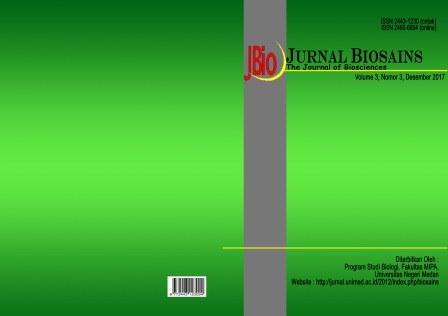ISOLASI DAN UJI ANTIFUNGAL EKSTRAK METANOL, ETIL ASETAT DAN N-HEKSANA BAKTERI ENDOFIT DARI AKAR TUMBUHAN MENTIGI (Vaccinium varingaefolium)
DOI:
https://doi.org/10.24114/jbio.v3i3.9794Keywords:
Endophytic bacteria, Vaccinium varingaefolium, Fusarium oxysporum, Ganoderma boninense, Rigidoporus microporus, Saprolegnia sp.Abstract
Many study that endophytic bacteria useful for plant by protection mechanism to parasitic disease and recovery plant morphology using metabolite producing. Many plants such as mentigi grow at extreme area in volcanic mount. This plant can be able to has specific metabolite producing endophytic bacteria. Research about plant endophytic at extreme area are still limited. The aim of this research to know plant endophytic frommentigi root in inhibiting pathogen fungi growing. plantendophytic bacteria isolation from mentigi root was done by root surface sterilization, cutting and cultivating on nutrient agar medium. Cell extraction was done using methanol, etil-asetat and n-heksana for two isolates. Antagonis test isolates and cell extract was done to some plant and fish pathogen fungus such as Fusarium oxysporum, Ganoderma boninense, Rigidoporus microporusand Saprolegniasp. on potatoes dextrose agar contain 1% yeast extract. Isolates AW5 and AW6 have high potential in inhibiting plant pathogen fungi growing.Essay result extraction to plant pathogen fungi showed that methanol extract of isolate AW5 and AW6 have biggest potential in inhibiting pathogen fungi growing.Downloads
Published
Issue
Section
License
Copyright (c) 2018 Widya Lestari, Dwi Suryanto, Erman Munir

This work is licensed under a Creative Commons Attribution 4.0 International License.
For Authors Jurnal Biosains agree to the following terms:
Authors retain copyright and grant the Jurnal Biosains (JBIO) right of first publication with the work simultaneously licensed under a Creative Commons Attribution License (CC BY-SA 4.0) that allows others to share (copy and redistribute the material in any medium or format) and adapt (remix, transform, and build upon the material) the work for any purpose, even commercially with an acknowledgement of the work's authorship and initial publication in JBIO (Jurnal Biosains)
Authors are able to enter into separate, additional contractual arrangements for the non-exclusive distribution of the journal's published version of the work (e.g., post it to an institutional repository or publish it in a book), with an acknowledgement of its initial publication in JBIO (Jurnal Biosains)
Authors are permitted and encouraged to post their work online (e.g., in institutional repositories or on their website) prior to and during the submission process, as it can lead to productive exchanges, as well as earlier and greater citation of published work (See The Effect of Open Access).


